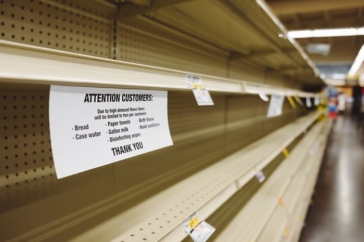-
ROSSLARE EUROPORT TARGETS HEALTH & SAFETY WITH CAMERA TELEMATICS PARTNERSHIP - 2 days ago
-
Landmark Study Reveals Wearable Robotics Significantly Boost Safety and Efficiency in Industrial Environments - July 24, 2024
-
Visku Tackle The Retail Seasonality Challenge One Pallet At A Time - July 22, 2024
-
KAMMAC AND BERGEN LOGISTICS STRENGTHEN FASHION & LIFESTYLE SERVICES IN THE UK - July 19, 2024
-
TENTBOX EXTENDS PARTNERSHIP WITH ARROWXL TO SUPPORT INCREASING DEMAND - July 17, 2024
-
The Perfume Shop improves customer journeys while driving profitability in partnership with Scurri - July 17, 2024
-
ZEROMISSION SECURES £2.3M ($3M) INVESTMENT TO ACCELERATE ELECTRIC FLEETS - July 16, 2024
-
BCMPA CELEBRATES SUCCESS OF 2024 CONFERENCE - July 15, 2024
-
Best of the Best: Jungheinrich Celebrates Triple International Award Win - July 12, 2024
-
GOPLASTICPALLETS.COM CALLS ON NEW CHANCELLOR RACHEL REEVES TO CONSIDER PLASTIC PACKAGING TAX REFORM - July 10, 2024
It’s that time of year when we are coming to the end of the winter sales and you can potentially bag a really good bargain, especially online. Many designer brands are offering 70% off and some even have extra discounts on top. That feeling when you realise the item you have silently been coveting is now within your grasp is priceless, you click to buy and get the email confirmation. Life is sweet. It’s an opportunity for the seller too, being able to shift all those old stock items that are clogging up the warehouse. Provided things go to plan.
But what happens when, 30 minutes later, the customer gets another email, this time telling them their order has been cancelled. Disappointment sets in. That special something isn’t coming your way after all. The item you thought you were buying isn’t actually available to buy. Maybe someone else got there before you did? Or maybe the stock level figures are incorrect. Most frequently it’s the latter scenario, because the seller doesn’t have end to end visibility of stocks in the warehouse being shared with its e-commerce storefront. Warehouse stock data is never fully up to date, either because the warehouse is managed using excel spreadsheets and paper sales order schedules, or because online order information is batch processed at set periods during the day. It is a frustrating but all too common scenario that can seriously impact customer goodwill levels. If shoppers start to suspect the accuracy of your ecommerce store, will they keep returning? Maybe not. More damaging, these disgruntled customers may choose to leave a negative review on Trustpilot, not because the stock sold is bad quality or faulty, but due to their disappointment over a stock accuracy mistake that is easily avoided.
Back office operations are also affected by these stock accuracy problems too, because a system that is poorly automated requires more costly human intervention. Operatives are required to process partial refunds and split orders, which can be time consuming and adds to the cost of completing the order itself, eating into profit margins. Using warehouse management system (WMS) software, it is possible to automate many routine and repetitive processes in the warehouse, which in turn helps to minimise the impact of exception handling and mitigates higher labour costs. Employees can frequently represent up to 50% of warehousing costs and a WMS will mitigate the impact of human errors, plus optimise resource utilisation. The potential savings can be very significant.
Investing in a WMS that communicates in real-time between the warehouse and store fronts can be one of the best commercial decisions your business makes. Stock accuracy mistakes that could leave bargain hunters feeling deflated won’t happen and there are many other benefits too. Using a WMS, it is possible to track stock items right down to the last item left in the warehouse accurately and avoid disappointing customers. If only a single product is left, when that last item is picked off the shelf, zero availability is immediately recorded and the item vanishes from view online. If more stocks can be ordered, the WMS can trigger an automatic replenishment request to suppliers. Then, if and when the item returns to stock – either because of a customer return or fresh delivery – the product can be re-displayed for sale. By tightly controlling all stock movements, a WMS controls what items the customer sees as available for sale and any mistakes are avoided.
The WMS also takes care of ongoing stock management and cycle counting automatically. This feature is also invaluable during the final weeks of a sale period. Each time an operative visits a particular location to pick stock for an order, they can be asked to confirm the numbers of items remaining, adding in a further check to warehouse processes. This is the Perpetual Inventory (PI) feature within Indigo WMS. Then, when the sale period is over and the business returns to normal operations, the warehouse can run more efficiently all year around, with orders processed quickly and efficiently, removing any negative impact of peak periods on staffing levels.
In addition to increasing stock accuracy levels, a WMS also helps companies to store more goods more efficiently, but using less warehouse space. Every single unit of space can be fully utilised without impacting on efficiency levels. At a time when increasing inflation is impacting warehouse rental rates, this is a significant benefit. A best of breed WMS can enable up to 30% more stock to be stored in a warehouse because it will suggest new locations that are being underutilised and then guides the operative to find the items when an order is received. There are other ways a WMS can improve stock management efficiency, by monitoring how frequently items will be picked and then suggesting the best places to store them in the warehouse and recommending whether items need special storage considerations.
Make 2023 the year that you decide to embrace the technology available and improve your order to despatch process by bringing calm to chaos.
If you would like to discuss how a WMS can help bring up to the second stock accuracy to your e-commerce operations, contact us for a business review meeting.
Author:
Eric Carter is a Solutions Architect at Indigo Software

































